STATEHOUSE REPORT | ISSUE 22.28 | July 14, 2023
BIG STORY: Heat to blast South Carolina over weekend
LOWCOUNTRY, Ariail: Soon will be less crowded
COMMENTARY, Brack: We’ve got a problem with gun violence, South Carolina
SPOTLIGHT: Riley Institute at Furman University
MY TURN, Ulbrich: Just say no to exempting state retirees from paying no income tax
MYSTERY PHOTO: Where is this wall?
FEEDBACK: Send us your thoughts
Heat to blast South Carolina over weekend
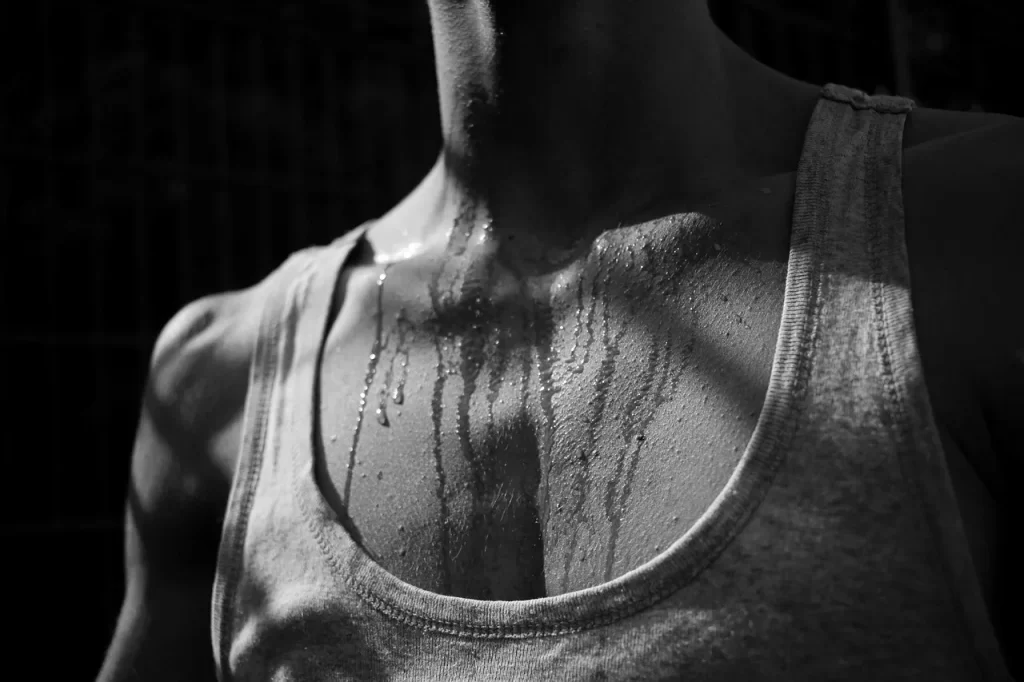
By Skyler Baldwin | A devastating heat wave that is keeping feel-like temperatures above 100 degrees is likely to get worse this weekend, forecasters say.
Heat advisories and warnings are in place from Arizona to Florida, impacting more than 111 million people, according to an Associated Press report. Some cities, like Phoenix, have registered temperatures above 110 degrees Fahrenheit for 13 consecutive days.
On Friday and Saturday in Columbia and Florence, temperatures will be in the low- to mid-90s, but the heat index for each will be 104 degrees to 106 degrees, according to the National Weather Service (NWS). In the Upstate, hazardous conditions will lead to triple-digit heat indices. Along the coast, temperatures may approach 90, but the heat index in Charleston will soar to the 100s. Myrtle Beach may get afternoon thunderstorms both days to keep the temperatures and heat index a little lower.
And it is going to get worse before it gets better, according to the NWS. More than 27 million people across the U.S. are expected to experience an air temperature or heat index above 110 degrees by early next week. Some areas in the Southwest may push closure to 130 degrees.
“Unfortunately, the long-term outlook through the weekend and into next week is for an increasingly significant and oppressive heat wave,” a recent NWS bulletin said.
What to watch for during extreme, dangerous heat
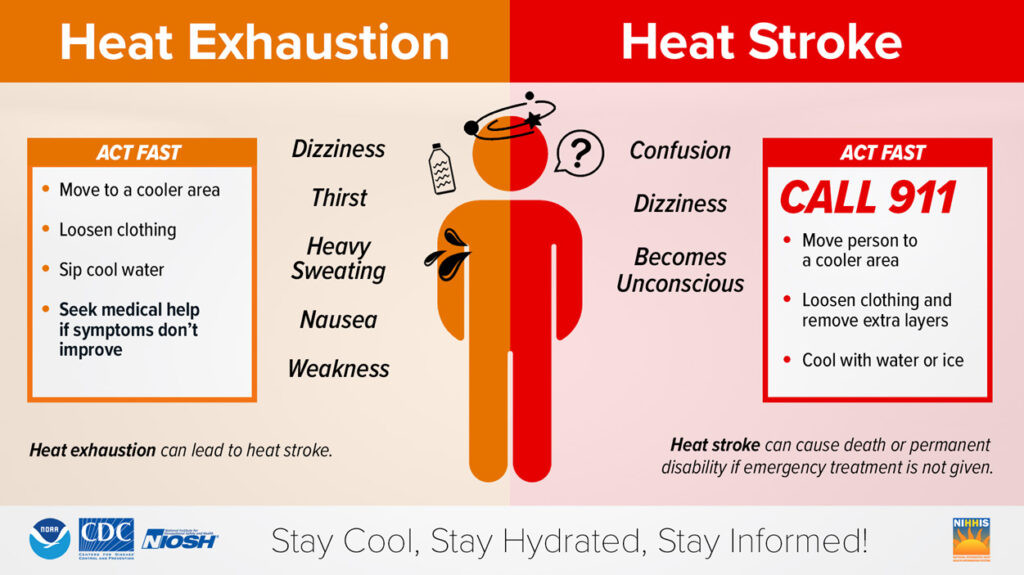
Prolonged exposure to extreme heat puts people at risk of several different health concerns, including heat stroke and heat exhaustion. It can also exacerbate other underlying health conditions like asthma.
“Make no mistake about it: This heat is deadly, and being in it for long periods of time is deadly,” Dr. Matthew Levy of the Johns Hopkins University School of Medicine said in a CNN report.
Be aware of the following warning signs and be prepared to take action, experts say.
- Heat cramps. This is often the first sign that the body is having trouble with the heat. Look out for heavy sweating, muscle pains and muscle spasms.
- What to do: Stop physical activity immediately and move to a cooler place. Seek medical attention if cramps last longer than an hour.
- Heat exhaustion. Heat exhaustion often preludes heat stroke and is an immediate sign of danger. Watch for a rapid pulse, flushed skin and profuse sweating as your body temperature increases. Heat exhaustion often leads to a mild form of shock.
- What to do: Loosen your clothes, place a cool wet cloth on your body or take a cool bath. Sip water slowly.
- Heat stroke. Heat stroke is a life-threatening condition that occurs when the body’s temperature control systems fail. Look out for severe headaches, confusion, nausea, dizziness and in severe cases, loss of consciousness.
- What to do: The body temperature can rise so high that brain damage and death may result if the body is not cooled quickly. A person who is experiencing heat stroke needs immediate medical attention.
- More info: Heat.Gov.
Tips for staying cool this summer
Braving the heat is a necessary part of summer. After all, life doesn’t stop just because the thermometer starts bubbling. So whether you’re heading to the pool or work, here are a handful of helpful tips to keep your temperature low.
Give yourself time to acclimatize. When a heat wave strikes, your body needs time to adjust. But it can take your body days to adjust properly. So if you’re planning a trip or vacation, plan to spend short periods in the heat in the days leading up to it.
Drink plenty of water. One of your body’s most robust cooling mechanisms is sweating, which rapidly lowers your body temperature. But it also drains you of water, so be sure to keep your bottle topped off and chilled. Don’t drink it all at once either, it’s better to consistently sip cool water than to down it in cups.
Wear loose, light clothing. If you’re spending time in the heat, what you wear matters. Seek lighter colors, because they tend to reflect heat rather than absorb it, and stay away from tight clothing, which blocks airflow and traps heat against your body.
Avoid alcohol. Go for a mocktail instead, as alcohol dehydrates you much faster, making it easier for your body to succumb to the heat in dangerous ways. And too much of it can impair your judgment, making it easier to miss the warning signs of heat exhaustion and even heat stroke.
Be aware of your car’s temperature. It’s easy to forget just how hot it can get inside of your car, but vehicles heat up incredibly quickly, even in moderate heat, due to a miniature greenhouse effect. This can be especially dangerous for children.
Skyler Baldwin is a reporter with the Charleston City Paper.
SC7 expedition highlights state’s natural beauty
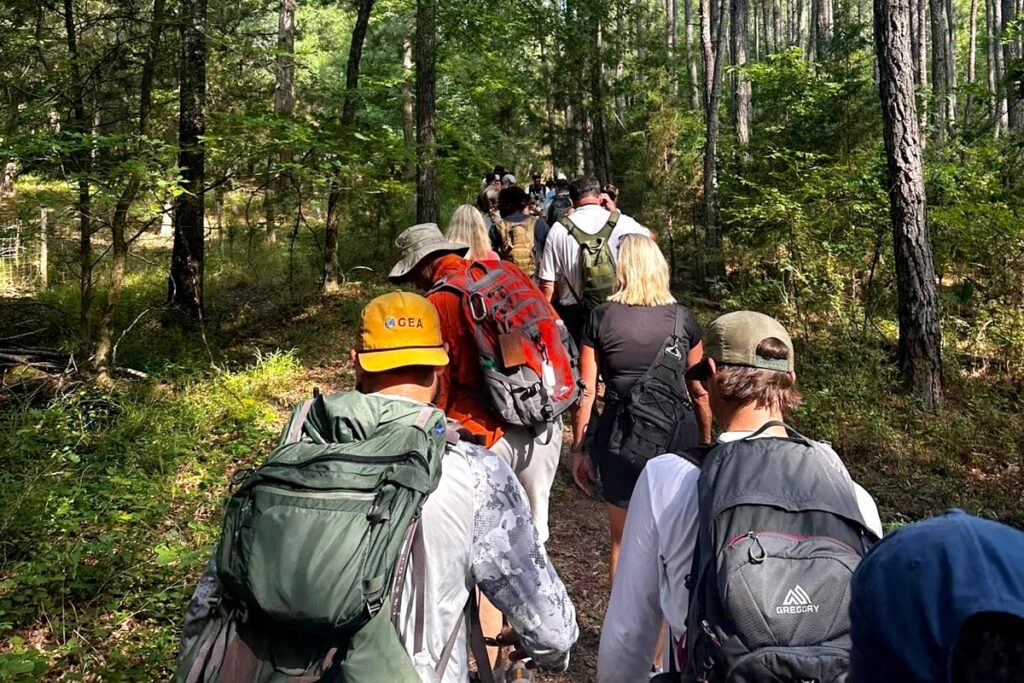
SC7, or the South Carolina 7 expedition, is bringing a group of hikers from across South Carolina to explore the state’s outdoors between Upstate and the coast. They’ll be in the Lowcountry in about two weeks after traversing hundreds of miles.
Started in 2020 as a way to bring attention to the state’s Floodwater Commission report, it has since become an annual July tradition.
“We’re taking South Carolina and encouraging people to understand the greatness of our state and the unparalleled uniqueness and beauty of our environment and ecology,” Camden resident and attorney Tom Mullikin, the man who led the commission in 2020, recently told reporters.
The expedition takes passengers across South Carolina on boats, rafts and their own two feet, starting in the Upstate, crossing through the Midlands and Pee Dee and ending along the coast. Over the course of 30 days, from July 1 to July 30, the group will visit national parks and historic sites, with a different adventure scheduled every day. This year’s stops include a visit to Parris Island to learn about its resiliency efforts and a day spent diving for fossils in the Cooper River.
In other recent headlines:
![]() More Lanxess chemical leaks revealed by the state. The Lanxess chemical plant in Charleston’s Neck area has experienced five leaks of highly toxic substances since 2018 that were reported to state health officials but not to the nearby Rosemont community, according to new state reports.
More Lanxess chemical leaks revealed by the state. The Lanxess chemical plant in Charleston’s Neck area has experienced five leaks of highly toxic substances since 2018 that were reported to state health officials but not to the nearby Rosemont community, according to new state reports.
Drunk driving convictions bring new ignition interlock requirements to S.C. Under the new law, anyone convicted of driving under the influence will have to breathe into a device that confirms no measurable alcohol levels exist before they can operate their vehicle.
Labor rift deepens between dockworkers, McMaster. Charleston’s unionized dockworkers and Gov. Henry McMaster are digging in their heels over a labor dispute that has left the Hugh K. Leatherman Terminal in Charleston largely inactive. A National Labor Relations Board decision that upheld unionized dockworkers’ right to exclusively staff the cranes at the terminal is pending, with an alternative so-called hybrid plan backed by McMaster.
S.C. residents lost $137K from scams in June. Ninety-one scams reported to the South Carolina Department of Consumer Affairs in June, resulting in a total loss of $137,068.93 among South Carolinians.
Price, fugitive for weeks after early release revoked, captured in N.Y. Fugitive Jeroid Price of South Carolina was captured Wednesday without violence at a New York City apartment after 11 weeks on the run since the S.C. Supreme Court revoked an unannounced deal that cut 16 years off of his 35-year murder sentence.
Charleston again voted best U.S. city by Travel + Leisure readers. The readers of Travel and Leisure magazine voted Charleston their number one city in the nation for the 11th consecutive year.
Charleston County shouldn’t have withheld information, Toal says. A judge ruled in favor of a local television station Monday in its lawsuit against the Charleston County Sheriff’s Office over its refusal to release jail video calls made by a suspect in a deadly DUI crash that killed a newlywed in Folly Beach in April. Former S.C. Supreme Court Justice Jean Toal, who retired from the high court in 2015 but serves as a judge when needed in other South Carolina courts, ruled the office violated the state’s Freedom of Information Act (FOIA) when it denied a request from WCSC-TV.
Inabinett laid to rest. Hundreds gathered Saturday to remember the life of former S.C. Rep. Curtis Inabinett Sr. Inabinett, a longtime state representative who served the Ravenel area, died at age 91 on June 26. “He was a good mentor, leader and a quiet voice in my ear,” Ravenel Mayor Stephen Tumbleston said. “And even though he walked softly, obviously he threw a lot of big influence in this town and this state.”
- Have a comment? Send to: feedback@charlestoncitypaper.com
Soon will be less crowded
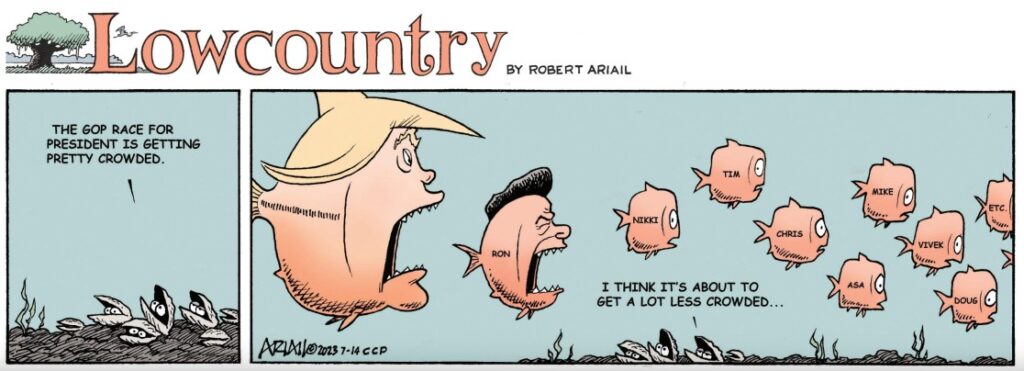
Cartoonist Robert Ariail generally has a biting or funny comment about the great state of South Carolina in his weekly cartoon. Here’s what he’s thinking about the crowded 2024 field of Republican presidential contenders. Love the cartoon? Hate it? What do you think: feedback@statehousereport.com.
We’ve got a problem with gun violence, South Carolina
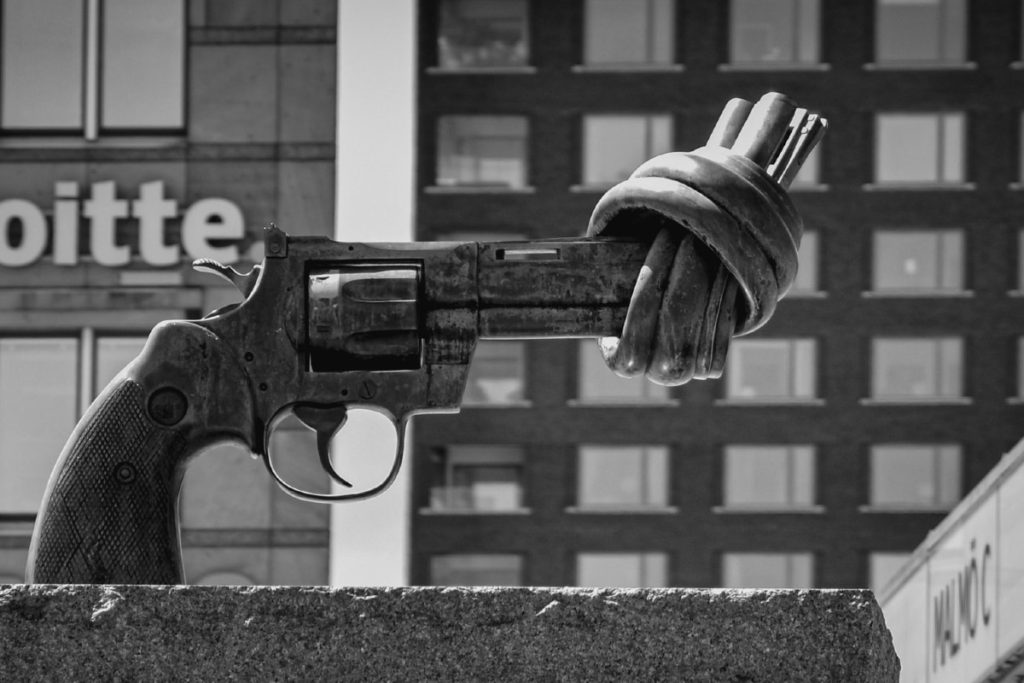
By Andy Brack, editor and publisher | The gun killings and shootings in South Carolina continue with devastating impact.
And the sad thing: We know what to do about them. But as a people, we just don’t have the courage to do anything.
 In the week leading to July 12, nine South Carolinians died after being shot in Charleston, Orangeburg, Beaufort, Lexington, Richland, Greenwood and Spartanburg counties. Six others were injured in shootings across the state, according to media and police reports.
In the week leading to July 12, nine South Carolinians died after being shot in Charleston, Orangeburg, Beaufort, Lexington, Richland, Greenwood and Spartanburg counties. Six others were injured in shootings across the state, according to media and police reports.
In Greenwood, for example, a 20-year-old man died in a hospital emergency room about 4 p.m. July 7 after being shot in the upper body. The death is being investigated as a homicide, but there’s no word on who shot him or any motive, according to one report. Two nights later, one man died outside of a Columbia apartment complex. The same day, also in Columbia, police put a tourniquet on a man who was shot and later died.
The week before: Eight died and seven were hurt in shootings around the state. The week before that: 10 died and 10 were shot. And the week before: Nine died and eight were hurt in gun incidents.
Over this past month this summer in South Carolina, at least three dozen people died because of guns. Another 31 were hurt.
Imagine this horrifying human impact by thinking of a group that’s about 75 people – a big football team, a medium-sized church, a packed local restaurant. One month it’s there and the next, it’s not. You’d notice.
What’s sadder is that those numbers are actually low, according to GunViolenceArchive.org, which tracks gun deaths and people injured by shootings. While its records show about the same number of South Carolina people died 30 days from mid-June to mid-July (34 versus 36), it documents that 66 people were hurt – 35 more than showed up in media reports.
All totaled in the Palmetto since the beginning of the year: 226 gun deaths and 393 people hurt by gun violence.
But we seem to ignore the continuing deaths and suffering thanks to guns.
Nationally, the numbers are even more alarming. As of July 14, more than 10,000 Americans died in shootings related to murders or unintentional shootings, according to the tracking organization. Another 12,870 committed suicide by gun. And so far this year as of July 14, the number of mass shootings – incidents in which at least four people are shot – is at 376. That’s more than happened in all of 2016 and 2017.
Gun violence is getting worse. The numbers prove it.
What’s frustrating to many is there are policy options that can limit the numbers of needless deaths and shootings – everything from banning some guns (which will never happen in South Carolina) to requiring registration to toughen access to dangerous weapons, mandating extensive training, closing loopholes, requiring more extensive background checks or even taxing bullets.
As we wrote last year, our leaders, particularly in the S.C. General Assembly, don’t seem to be doing their jobs in taking on this increasingly deadly problem:
“Unfortunately, about half of the people elected to Congress and state legislatures stick their fingers in their ears and hum, ‘nah, nah, mmm, mmm’ to avoid engaging on the subject. It doesn’t help that the majority of them have been co-opted by a rabid gun lobby with gazillions of dollars that make politicians cower like Harry Potter house elves.
“Nevertheless, we have a duty to pull our heads out of the political sand and deal with the gun intransigence that has swept across America. Too many people are dead. Perhaps the only real way to get something done is to hold politicians more accountable. Nothing else seems to work. So let’s get loud and force them to state their positions and take action, instead of avoiding and deflecting. And then let’s vote them out of office if they won’t do what they are elected to do – take on tough issues and fix huge problems.”
Stop the dawdling, lawmakers. For a change, make a difference to make our communities safer.
Award-winning columnist Andy Brack is editor and publisher of Statehouse Report and the Charleston City Paper. Have a comment? Send to: feedback@statehousereport.com.
Riley Institute at Furman University
 The public spiritedness of our underwriters allows us to bring Statehouse Report to you at no cost. This week’s spotlighted underwriter is Furman University’s Riley Institute, which broadens student and community perspectives about issues critical to South Carolina’s progress. It builds and engages present and future leaders, creates and shares data-supported information about the state’s core challenges, and links the leadership body to sustainable solutions.
The public spiritedness of our underwriters allows us to bring Statehouse Report to you at no cost. This week’s spotlighted underwriter is Furman University’s Riley Institute, which broadens student and community perspectives about issues critical to South Carolina’s progress. It builds and engages present and future leaders, creates and shares data-supported information about the state’s core challenges, and links the leadership body to sustainable solutions.
Launched in 1999, the Institute is named for former South Carolina Governor and former United States Secretary of Education Richard W. (Dick) Riley. It is committed to nonpartisanship in all it does and to a rhetoric-free, facts-based approach to change.
- Learn more about the Riley Institute.
- Also learn more about the Riley Institute’s Center for Education Policy and Leadership.
Just say no to exempting state retirees from paying no income tax

By Holley Ulbrich | A proposal has been floated to exempt retired state employees from paying state income taxes. The basis for this proposal is that the only cost-of-living adjustment retirees get from the state retirement system is an annual 1% of their pension, with a maximum of $500 a year.

Since inflation has been a good bit higher than 1% in the last couple of years, the complaint is understandable. It’s just not clear that exempting state retirees from state income taxes is a good solution.
Who would benefit? Because of the way the income tax system is structured, the benefits would go to higher-income retirees, while retirees with less than median income would gain nothing. They are already not paying any state income tax.
Why? Let’s look at some approximate numbers. The average state retiree gets a pension of about $21,000. An average Social Security payment to accompany that pension of about $14,000. Social Security is not taxable in South Carolina. There is a $10,000 pension exclusion and a standard deduction of about $15,000 for those over age 65. So that “average” state retiree (single, 65 or older) who has an income of up to $40,000 consisting of only social security and a state pension is already not paying any state income tax . All of the benefits of the [proposed] exemption would accrue to those retirees with higher pensions or other sources of income. But most of the costs of inflation have been falling on low-income households because of the concentration of rising prices on rent and food.
Another reason to say no
A second reason to oppose this proposal would compare the net income of retirees to that of current state employees. Why do we want to discriminate against state workers when we have so many unfilled vacancies?
Let’s compare the situation of that retiree with a $40,000 income with a current state employee (single, no children) with the same income from a salary. All that person’s income is subject to state income taxes, although they also get a smaller standard deduction of just over $12,000. State income tax would be about $1,500.
Also: State workers don’t get a Social Security check. Instead, Social Security withholds 7.6% of their income to provide benefits for retirees, disabled workers and Medicare for those over 65. Subtract another $3,000. Another 9% of their salary goes toward the state retirement system to support those same retirees. Subtract another $3,600. That state worker has a net salary after pension contributions, Social Security taxes and state income taxes that is $8,100 less that his retired neighbor. In addition, state workers do not receive a regular cost-of-living adjustment. They get whatever the legislature decides to give them, which was pretty decent this year but has been nothing in many past years. Social Security recipients get a regular COLA, which was 8.7% for the most recent year. Given how hard it is for the state to recruit and retain state workers, especially nurses, teachers and prison guards, why do we make the imbalance worse?
There are other objections to this proposal. For example, reducing state income tax revenues by a series of cuts in the top rate and exempting military pensions also reduces the base on which state aid to city and county governments is calculated, so they get less state aid. It is particularly hard on counties, which have a lot of shared responsibilities with the state—libraries, roads, the judicial system and health services, just to name a few.
What, if anything, should we be doing for our retired state employees? Giving them a cost of living adjustment out of the retirement system is out of the question. The state is on a slow but steady path to ensure that the retirement system is fully actuarially funded by some time in the 2030s.
A less costly alternative might be to increase the pension exclusion to, say, $13,000 and index it for inflation which are currently in place for other elements of the tax code. But only if there is some kind of commitment of inflation adjustments for state employees. Fair is fair.
Holley Ulbrich is retired professor emerita of economics from Clemson University.
Where is this wall?
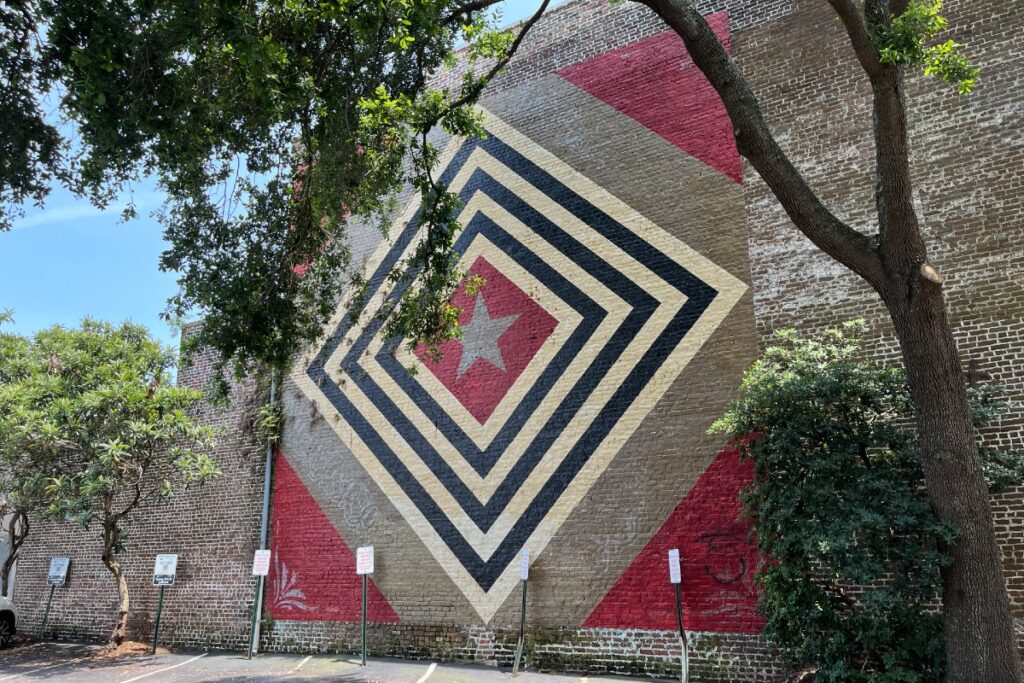
Here’s an interesting wall. Where is it? Can you tell us anything interesting about it? Send us your guess of what this photo shows – as well as your name and hometown – to feedback@statehousereport.com.
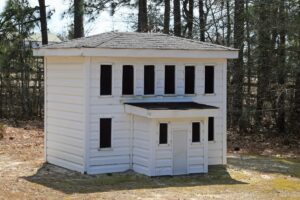 Last week’s “What’s the story behind this photo?” got a lot of great guesses. But the photo, sent in by Bill Segars of Hartsville, shows a model of a school in Kershaw County that burned down 100 years ago, killing 77 children and adults.
Last week’s “What’s the story behind this photo?” got a lot of great guesses. But the photo, sent in by Bill Segars of Hartsville, shows a model of a school in Kershaw County that burned down 100 years ago, killing 77 children and adults.
“That is the model of the Cleveland School building that burned May 17, 1923,” said new sleuth Lisa Freeman of Camden. “It was the deadliest fire in South Carolina history. It changed the fire codes.”
Wesley Brewer, a former Camden resident who lives in Goose Creek, added, “It burned on the last day of school as the community was watching a play when an oil lamp fell to stage and people panicked. Almost everyone in the community lost loved ones.”
Others who correctly identified the model were: Heather Hudson of North Charleston; David Lupo of Mount Pleasant; George Graf of Palmyra, Va.; Cathy Polk of Cassett; Allan Peel of San Antonio, Texas; Jay Altman and Elizabeth Jones, both of Columbia; Michael Webb of Hartsville; Frank Bouknight of Summerville; Jane Scott of Camden; as well as Lewis Smith and Ashley Welborn, both of whom didn’t provide a hometown.
>> Send us a mystery picture. If you have a photo that you believe will stump readers, send it along (but make sure to tell us what it is because it may stump us too!) Send to: feedback@statehousereport.com and mark it as a photo submission. Thanks.
Send us your thoughts
We encourage you to send in your thoughts about policy and politics impacting South Carolina. We’ve gotten some letters in the last few weeks – some positive, others nasty. We print non-defamatory comments, but unless you provide your contact information – name and hometown, plus a phone number used only by us for verification – we can’t publish your thoughts.
- Have a comment? Send your letters or comments to: feedback@statehousereport.com. Make sure to provide your contact details (name, hometown and phone number for verification. Letters are limited to 150 words.
- ORDER NOW: Copies are in Lowcountry-area bookstores now, but if you can’t swing by, you can order a copy online today.
- Now available as an e-book!
ABOUT STATEHOUSE REPORT
Statehouse Report, founded in 2001 as a weekly legislative forecast that informs readers about what is going to happen in South Carolina politics and policy, is provided to you at no charge every Friday.
- Editor and publisher: Andy Brack, 843.670.3996
Donate today
We’re proud to offer Statehouse Report for free. For more than a dozen years, we’ve been the go-to place for insightful independent policy and political news and views in the Palmetto State. And we love it as much as you do.
But now, we can use your help. If you’ve been thinking of contributing to Statehouse Report over the years, now would be a great time to contribute as we deal with the crisis. In advance, thank you.
Buy the book
Now you can get a copy of editor and publisher Andy Brack’s We Can Do Better, South Carolina! ($14.99) as a paperback or as a Kindle book ($7.99). . The book of essays offers incisive commentaries by editor and publisher Andy Brack on the American South, the common good, vexing problems for the Palmetto State and interesting South Carolina leaders.
More
- Mailing address: Send inquiries by mail to: P.O. Box 21942, Charleston, SC 29413
- Subscriptions are free: Click to subscribe.
- We hope you’ll keep receiving the great news and information from Statehouse Report, but if you need to unsubscribe, go to the bottom of the weekly email issue and follow the instructions.
- Read our sister publication: Charleston City Paper (every Friday in print; Every day online)
- © 2023, Statehouse Report, a publication of City Paper Publishing, LLC. All rights reserved


